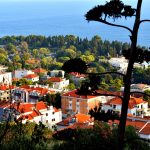They say Croatia is the best country in Europe for raising children.
Croatian counties along the coast, especially Split-Dalmatia, Zadar, Dubrovnik-Neretva and Istria County, are increasingly being populated by citizens from more developed countries of the European Union. The trend of immigration is currently at the very beginning, but it will only intensify in the future. So far, Croatian towns along the coast, but also on the islands, are mostly populated by expatriates from Slovenia, Germany, Italy and Austria who own real estate or businesses in Croatia, but among immigrants from the European Union there are also people from Great Britain, Poland, France, Sweden… who mostly choose to move to the south of the country, reports Večernji List on February 13, 2017.
While the continental part of Croatia, with the exception of Zagreb and Zagreb County, is losing population due to intensive emigration in recent years, Split-Dalmatia, Zadar, Dubrovnik-Neretva and Istria County are only parts of the county where there has been an increase in population in the past decade, at least for a few thousand. Therefore, these counties, unlike the rest of the country, are non threatened by demographic catastrophe.
This is also demonstrated by the estimates of the total population of counties announced by the Central Bureau of Statistics, particularly if we compare data for 2005 and 2015. In these ten years, in addition to Zagreb, which has grown by 22,500 inhabitants, and Zagreb County, the population has grown only in the four coastal counties, with the largest increase being recorded in Zadar County, which has about 8,000 people more.
In 2015, 2,192 EU citizens have moved to Croatia, while in 2014 that number was 2,334. Foreigners from EU countries have mostly settled in Istria, Split-Dalmatia, Primorje-Gorski Kotar, and Zadar County, as well as in the City of Zagreb.
World traveler and blogger Paul Bradbury from Great Britain explained why Europeans from more developed countries are attracted to the Croatian coast and islands. He substituted the rain in Manchester with the sunny island of Hvar, and he is the author of the extremely popular website www.total-croatia-news.com, which promotes Hvar, Dalmatia and Croatia in English language. And he is not the only one who lives in Dalmatia, since 78 of his former fellow citizens settled in Split-Dalmatia County in 2015. In 2014, there were 109 Britons who moved from Britain to Croatia.
“What do I miss from England? Frankly, almost nothing, maybe rain. When you are born in rainy Manchester and move to the sunniest island in Europe, what is there to miss?!” says Bradbury who has been living in Jelsa for the last 15 years. However, after some reflection, he says that Croats cannot be proud of a range of cuisines found in Croatia. “I love Asian cuisine which is hard to find in Croatia, but things are improving slowly. But, really slowly”, says Bradbury.
He adds that the best thing about life in Croatia are safety and strong family ties that Croats cherish. “I cannot imagine a better place in Europe to raise children. Safety level is high, the nature is beautiful, there are no commercial pressures, and family ties are strong so children grow up with the strong support of parents. Many of these values have been lost in the so-called civilized West”, says Bradbury.
It is no secret what he believes is the worst thing in Croatia. “Corruption, of course”, he says without even thinking. He wrote a blog article about corruption recently titled “Welcome to Uhljebistan”. “The potential of Croatia is incredible, but the level of bureaucracy is scandalous”, says Bradbury.
Among migrants to Croatia from other EU countries, the first place for now belongs to Slovenes. In 2015, 502 Slovenian citizens moved to Croatia, and most of them settled in Istria and Primorje-Gorski Kotar County. They were followed by Germans, with 439 people moving to Croatia this year and 486 in 2014. Most of them settled in Split-Dalmatia County, in Zagreb and in Istria County. Italians (351) have mostly settled in Istria County and Primorje-Gorski Kotar County.
Looking at the age structure of foreign nationals moving to Croatia, most of them are middle-aged and older, but the data show that the Croatian coast is not attractive only to wealthy retirees from Western countries. In 2015, among the 2,192 EU nationals moving to Croatia, there were 828 people younger than 40.
Demographer Stjepan Šterc points out that the substitution of the population from European countries in Croatian counties, which are located primarily along the coast, in still in its infancy. And it will continue. “For now, citizens of the European Union coming here are those who own property and businesses along the coast, and the trend of immigration will only intensify in the coming years. When the process is sped up, it will include the more general population of the EU countries that will settle in Croatian counties along the coast and which now does not own real estate or companies in Croatia. Croatia is attractive to foreigners because of its safety and the beauty of the coast, and that is the reason why EU citizens will settle along the coast, but not in the interior of the country”, says Šterc. EU citizens moving to Zagreb, according to Šterc, are mostly connected with foreign companies which employ their own citizens.
But, regardless of the fact that the Croatian coast is attractive to wealthy Europeans, it cannot be expected that their immigration will contribute to demographic recovery of the country, since the number of people moving out of Croatia is much greater than the number of immigrants. It is only an indication that the most beautiful Croatian regions will not be left empty and that there will always be interest for them because of their natural beauty, climate and safety.
In 2015, 11,706 people moved to Croatia from abroad, including 6,483 Croatian citizens. At the same time, according to estimates of demographers, more than 50,000 Croatian citizens moved out of the country. “These are just small droplets of immigrants from the EU to Croatia, compared with how much population Croatia loses. Foreigners from the EU have settled primarily on a narrow coastal strip, while the inland part of Dalmatia is empty and more vulnerable even than the islands. Among EU citizens are those who buy real estate in Croatia, rent it and do not pay taxes, saying that their relatives are spending summer months here”, says demographer Anđelko Akrap.
Due to the climate and natural beauties of towns along the coast, it is expected that they will continue to be attractive to wealthy Europeans in the future as well. Akrap believes that, in the short term, there is no danger of population replacement along the coast. That could happen in the long run if negative demographic trends are not reversed. According to data and demographic estimates, only Zagreb and coastal countries do not have to fear a demographic catastrophe, while all other parts of the country, unless something is changed drastically, are facing havoc.







